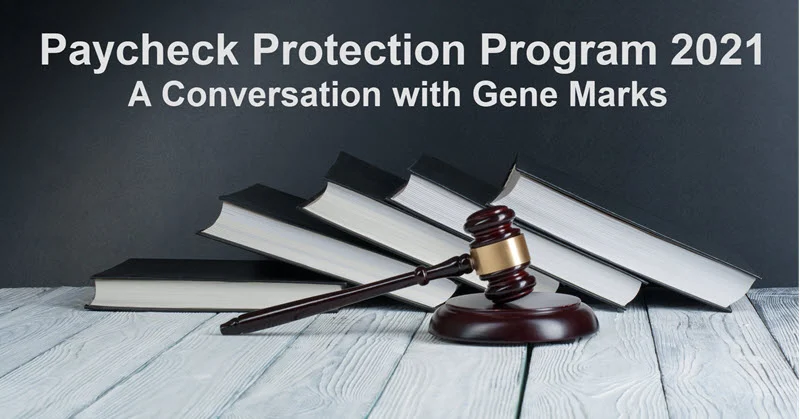Joining us today is Gene Marks from the Marks Group PC. He is an author, a speaker on small business expertise, and a CPA. He has presented at Scaling New Heights. He was one of our guests on the Round Tables back in March for the CARES Act when we were trying to figure out what was happening with coronavirus relief. He writes regularly for The Hill, the Philadelphia Inquirer, Forbes, Entrepreneur Magazine, and The Guardian, and appears regularly on MSNBC, CNBC, Fox Business and Fox News. He’s the author of six books on business management and comes to us today compliments of our friends at Patriot Software, a leading payroll provider which works with QuickBooks Integrated Payroll.
Joe Woodard: Can you talk a little bit about the employee retention credit?
Gene Marks: Yes. There have been many changes made to the employee retention credit. So, you're still in operation, you still have your employees and you're paying them. The government is saying: For any amount up to a certain amount that you're paying your employees, we're going to give you a tax credit against your employer’s portion of FICA. You can claim this credit on your 941 quarterly tax returns, and if this tax credit is bigger than what you are supposed to pay or have paid in for your FICA, then you can get the money back in the form of cash. So it's like a refundable tax credit. That's what it originally was. Under the old rules from the CARES Act that was supposed to expire at December 31, 2020, the retention credit has been extended until July 1, 2021. So for the first and the second quarter of 2021, the tax credit still exists.
Now before, you had to have less than 100 employees to qualify for the RTC. Now, for the last two quarters and for 2021, you can have as many as 500 employees to be eligible for the employee retention tax credit. You must show proof that your business was shut down or you suffered revenue loss. Again, this is quarter to quarter. So before it was 50% in the quarter versus the prior year. Now the bar has been raised. You must show that your business lost 80% of revenue compared to the prior quarter of 2019. So again, this credit is really positioned for companies that are suffering during COVID-19, such as restaurants, retailers and fitness centers and other people that have really suffered significant revenue losses.
Joe Woodard: If your business is shut down, is that because of federal or state or even municipality rules don’t allow you to open your doors, you’re eligible? For what duration of time?
Gene Marks: It's any duration of time that you have been shut down. Most of the shutdowns have been weekly.
Joe Woodard: A lot of people would qualify. Then if at any point during 2020-
Gene Marks: That is correct. And through 2021 because we don't know what's going to happen in the next few months. If you shut down, you add that revenue loss. To calculate this credit before, the wage limit was $10,000 per year per employee. Now, you can do it on a quarterly basis. So, if you qualify for the credit, it's now $10,000 per quarter per employee. Under the new rules, $7,000 per employee per quarter can be eligible for this tax credit against the FICA taxes that you paid in. And if the credit exceeds the FICA taxes you would get the money back in the form of cash.
Another big change: before, if you participated in PPP you couldn't participate in the employee retention tax credit. Now even if you’re getting a PPP loan, you can still take advantage of the employee retention tax credit. However, this is tricky. The government is saying is that you must separate out the payroll, Whatever payroll that you're using to get PPP forgiveness, you can't use that same payroll in your calculation for the employee retention tax credit.
Joe Woodard: What is annual in one is just over a smaller period of time, so that could technically work.
Gene Marks: Correct. And I listened. My fear is that we're telling our clients to be aggressive about this and go after it. If you've got a single dollar that you can apply towards the, you know, to have his tax credit and do it. Now you can go back and calculate it for 2020. So if you didn't meet any of these criteria before, but now you do, you can go back and recalculate this employee retention tax credit. You can get money back that you previously paid in because you didn't qualify before these new rules took effect going into 2021.
And when you are calculating your payroll, you can include the employer share of group health insurance in the 70% payroll calculation for the credit.
Joe Woodard: I've got a question about the actual mechanism for applying for this tax credit. It's done through the quarterly 941?
Gene Marks: It is on the 941. The 941 forms have been adjusted to accommodate applying for this credit. The calculation is done separately. Also, if you do the calculation in advance and you think that you're going to use up all of these amounts as part of the credit, you do not have to pay the FICA taxes if you think you're just going to get them all back in the form of a credit. So it does behoove you to work with your payroll company and your accountant. Do the calculation for this quarter coming up and save the money. It's silly to pay it in and then have to come back and apply for the credit to get it back again.
Joe Woodard: I'm sure we keep telling our clients that's the nature of a refund: a loan without interest, but I don't know that they always get it. It's kind of the same principle with income tax: why overpay to get a refund?
Gene Marks: I definitely have. I also want to also mention one other thing. There's also been a change to the deferred Social Security taxes. The employee retention tax credit is available to those companies that have really been affected by COVID-19: lost 80% of revenue. However, any company can take advantage of this social security tax deferral. If you don't want to pay your employer’s portion of FICA taxes, you can, for now through March 30, 2021, hold on to that money and not pay it. You can pay 50% of it back in 2021 and the remaining 50% in 2022. It's a very low interest rate. Just be aware that this isn't a tax credit because you do have to pay the money back. But if you need the cash, now you can hold on to it for your company’s portion of social security taxes. Again, that's separate from the employee retention tax credit.
.png?width=150&height=63&name=TWRlogo-regmark_blueblack%20(1).png)
.png)










Do you have questions about this article? Email us and let us know > info@woodard.com
Comments: